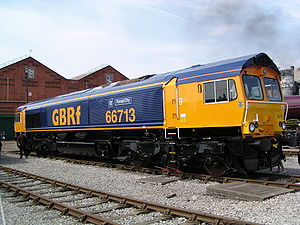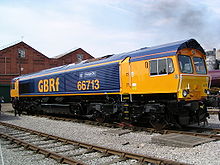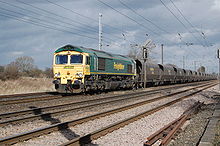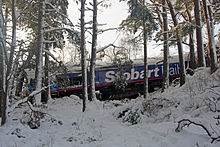- British Rail Class 66
-
British Rail Class 66 
66713 'Forest City' at Crewe Works Power type Diesel-electric Builder Electro-Motive Diesel Model JT42CWR or Series 66 Build date 1998-2008 Total produced 446 Configuration Co-Co UIC classification Co'Co' Gauge 1,435 mm (4 ft 8 1⁄2 in) Standard gauge Bogies HTCR radial Wheel diameter 1,066 mm (42.0 in) Minimum curve 4 chains (80 m) Wheelbase 17.29 m (56 ft 9 in) (between bogies)
4.15 m (13 ft 7 in) (bogies)Length 21.4 m (70 ft 3 in) Width 2.65 m (8 ft 8 in) Height 3.9 m (12 ft 10 in) Locomotive weight 129.6 tonnes (127.6 long tons; 142.9 short tons) Fuel capacity 6,400 litres (1,410 imp gal; 1,690 US gal) Prime mover EMD 12N-710G3B-EC
Class 66/9: EMD 12N-710G3B-T2Alternator GM-EMD AR8 Traction motors 6 of GM-EMD D43-TR Multiple working AAR system (Classes 59, 66 & 67) Top speed Class 66/6: 65 mph (105 km/h)
Balance of fleet: 75 mph (121 km/h)Power output Engine: 3,300 bhp (2,460 kW)
at rail: 3,000 bhp (2,240 kW)Tractive effort Maximum: 409 kN (91,900 lbf) at starting
Continuous: 260 kN (58,500 lbf) at 15.9 mph (25.6 km/h)Train heating None Locomotive
brakeforce68 tonnes (67 long tons; 75 short tons) Train brakes Westinghouse PBL Air Career Colas Rail
DB Schenker
Direct Rail Services
Freightliner
GB RailfreightNumber 66001–66250 66301–66305 66411-66434 66501-66599 66601–66623 66701–66746 66846-66850 66951–66957 Nicknames 'Shed' 'Ying-Ying' Axle load class Route availability 7 The Class 66 is a six axle diesel electric freight locomotive developed in part from the British Rail Class 59, for use on the railways of the UK. Since its introduction the class has been successful and has been sold to British and other European railway companies. In Continental Europe it is marketed as the EMD Series 66 (JT42CWR).
Contents
History
United Kingdom
On the privatisation of British Rail's freight operations in 1996, English, Welsh and Scottish Railway bought most of British Rail's freight operations. Many of the locomotives that EWS inherited were either at the end of their useful life or of doubtful reliability. EWS approached General Motors Electro-Motive Division (EMD), who offered their JT42CWR model which had the same bodyshell as the EMD built Class 59; this gave the advantage of having a locomotive of known clearance. The engine and traction motors were different models from those in the Class 59. Additionally, the Class 66s incorporated General Motors' version of a steering bogie - designed to reduce track wear and increase adhesion on curves.
The initial classification was as Class 61, then they were subsequently given the Class 66 designation in the British classification system (TOPS). Two hundred and fifty were ordered and built in London, Ontario, Canada.[1]
In 1998, Freightliner placed an order for locomotives. They were followed by GB Railfreight, and then Direct Rail Services.
Although sometimes unpopular with many rail enthusiasts, due to their ubiquity and having caused the displacement of several older types of (mostly) British built locomotives, their high reliability has helped rail freight to remain competitive.
Continental Europe
Main article: EMD Series 66The Class 66 design has also been introduced to Continental Europe where it is currently certified for operations in Germany, the Netherlands, Belgium, Luxembourg, Sweden, Norway, Denmark, France, and Poland, with certification pending in the Czech Republic and Italy. They currently operate on routes between Sweden and Denmark and between Germany, Belgium, The Netherlands and Poland. As a result of its well-known British identity, EMD Europe markets the locomotive as "Series 66".
Operators
DB Schenker
English, Welsh and Scottish Railway (now DB Schenker Rail (UK)) was the first to order Class 66 locomotives, with the first of the two hundred and fifty locomotives shipped to Britain in mid-1998. The final locomotive entered traffic just two years later, in mid-2000. The EWS fleet includes five locomotives capable of banking heavy trains over the Lickey Incline—on these specific locomotives, the knuckle coupler has been modified to allow remote releasing from inside the cab, whilst in motion.[2] It also includes fifteen locomotives fitted with RETB signalling equipment, for working in northern Scotland and RETB-fitted branchlines.[2]
Freightliner
Freightliner followed EWS by initially ordering five new Class 66/5 locomotives, and have continued to order in small batches. As of summer 2010, the 66/5 fleet had reached 98 examples, numbered 66501-520/522-599. 66521 was withdrawn after the 2001 crash at Great Heck and later scrapped.
In 2000 a new Class 66/6 sub-class was built, with a lower gear ratio, enabling heavier trains to be hauled, albeit at slower speed. There are presently 25 examples of this class, numbered 66601-625.
During 2004 the company also took delivery of the most recent Class 66/9 sub-class of the locomotive, which are a low-emission variant. All new locomotives for all companies are now of the low-emission "T2" type. The original two such locomotives remain as 66951/52.
GBRf Europorte
 66713 'Forest City' at Crewe Works in original GBRf livery
66713 'Forest City' at Crewe Works in original GBRf livery
GB Railfreight leased seventeen Class 66/7 locomotives from HSBC Rail. GBRf's fleet increased to 32 locomotives.[when?] The locomotives are employed on infrastructure contracts with Network Rail and London Underground. GBRf also haul intermodal container trains from Felixstowe to the West Midlands and coal trains to Ratcliffe, Lynemouth and Drax power station.
During April 2006 five more locomotives (numbered 66718-722) were delivered. These are of the low-emission kind, similar to the 66/9s in service with Freightliner. Their livery differs slightly from the original seventeen, using a lighter blue and 'Metronet' branding on the sides. Their primary use was to work infrastructure trains for Metronet, but now for Metronet's successor Transport for London. A further order for five more locomotives (66723-727) was delivered in early 2007, and painted in a new livery of pink, white and blue, which is similar to First Group's corporate livery. In April 2008 First GBRf took delivery of another five locomotives (66728 - 732), again painted in the corporate First Group livery.
As of February 2011 66401-66405 have started to be renumbered into the 66/7 number series and will eventually be repainted.[citation needed]
In 2011 66720 was painted in a special "Rainbow" livery.[3]
Direct Rail Services
 Direct Rail Services Class 66 locomotive 66412, in 'Compass' livery
Direct Rail Services Class 66 locomotive 66412, in 'Compass' livery
Direct Rail Services (DRS), a subsidiary of British Nuclear Fuels (BNFL) leased Class 66 locomotives from Porterbrook. Previously, they had relied on a fleet of ageing second-hand Class 20, Class 33, Class 37 and Class 47 locomotives. In 2002, DRS ordered ten Class 66/4 locomotives from EMD. These were delivered in 2003, numbered 66401–410, and are employed on new Anglo-Scottish traffic, some with Stobart Rail. They are painted in a variation of DRS's blue livery, with two locomotives, 66411 and 66414, in Stobart Rail livery. More locomotives have since been ordered, with ten (66411–420) again T2 style spec locos, delivered in 2006 and another ten (66421–430) delivered in late 2007. As of 2008, DRS had another four locomotives (66431–66434) on order.
DRS have now returned 401-10 as they are high emission locos thus meaning they are the newest fleet set to reach storage.[when?][citation needed]. DRS 66s now see regular work on Nuclear Flask trains running from several locations as Carlisle Kingmoor, Sellafield, Crewe, Dungeness, Willesden, Seaton and Berkeley. This is due to the ageing class 20s needing major overhauls. Most are now in storage or on hire to GBRF to deliver new LUL stock.[citation needed]
Colas Rail
Colas Rail took over the ex-Advenza Cemex Cement flow after the company went bust utilising ex Advenza locomotives. During 2010 they took on 66843 and laterly 66844 which both had been on lease to GBRf, they also took on ex DRS 66410 which was renumbered 66845.
Former operators
Advenza Freight
Advenza Freight, a Cotswold Rail subsidiary, operated class 66841-844. They were primarily used on Advenza's scrap and cement flows. The locomotives originated from the batch that DRS returned. Advenza Freight went bust in October 2009 and the class 66s returned to storage.
Fastline
Fastline Freight, part of Jarvis PLC, which operated intermodal services between Doncaster and Birmingham International Railfreight Terminal (BIFT), and Thamesport, in North Kent, using refurbished Class 56 locomotives, ordered five Class 66/3 locomotives to operate a coal flow from Hatfield Colliery. They were delivered in 2008.[4] Following the demise of Jarvis in 2010, and Fastline going into administration on 29 March 2010,[5] these locomotives were placed in store, being towed to DRS Carlisle Kingmoor or Crewe Gresty Bridge depot for storage.[6]
Sub-classes
Minor differences between different orders, and different operating companies have resulted in a number of subclasses being defined.[7]
Subclass Number built TOPS number range Operators Comments 66/0[1] 250 66001-66250 DB Schenker The original order of 250. The first loco arrived at Immingham in 1998.[1]
60 EWS locomotives lent from EWS stock to EWSi subsidiary Euro Cargo Rail although some are back in the UK now.[when?] DBS are now sending locos to Poland.[when?]66/3 5 66301-66305[8] Direct Rail Services Ordered to service a coal contract.[9] Former operated by Fastline. 66/4 3 66402-66404 GB Railfreight 23 66411-66434 Direct Rail Services Intended use is on intermodal traffic. Occasionally used on nuclear flask traffic - for which they are overpowered.[1] 66/5 85 66501-66520, 66522-66572, 66585, 66587-66599 Freightliner Replaced Class 47s and Class 57s on Intermodal freight.[1]
66521 written-off after Selby rail crash. 66582, 66583, 66584 and 66586 have been exported to Poland, the operating subsidiary Freightliner PL.66/6 19 66601-66607, 66610, 66613-66623 Freightliner Top speed of 65 mph (105 km/h) - reduced gearing to cope with heavier oil, aggregates and cement trains.[1]
66608, 66609, 66611, 66612, 66624 and 66625 have been exported to Poland, the operating subsidiary Freightliner PL.66/7 34 66701-66746 GB Railfreight Operates on coal, intermodal services and also engineering / departmental work for Metronet and Network Rail on London's underground and national rail lines.[1] - 66733 to 66737 in Former Direct Rail Services (66401-66405) operations.
- 66738 to 66741 in Former Freightliner (66578-66581) operations.
- 66742 to 66746 of the Colas Rail (66841-66845) has been transferred.
66/8 5 66846-66850 Colas Rail Former operated by Freightliner 66573-66577. 66/9 7 66951-66957 Freightliner A lower emission variant - fuel capacity reduced to compensate for the increased weight of other components.[1] Cab design problems
The British Trade Union ASLEF has complained that the locomotives are unfit and unsafe to work in, citing a lack of air conditioning, and poor seating and noise levels.
In April 2007 ASLEF proposed a ban on their members driving the locomotives during the British summer 2007 period. Keith Norman, ASLEF's general secretary, described the cabs as "unhealthy, unsafe and unsatisfactory". Research showed that in July 2006, when the weather had been extremely hot, the number of times a driver had passed a red signal increased.[10] EWS entered into discussions and make amendments to a series of trial locomotives,[10] GB Railfreight and Freigtliner also investigated cab improvemetns.[11] In June 2007 progress on the issue led ASLEF to withdraw its threat of industrial action.[12]
In Norway CargoNet related complaints about the noise levels in the CD66 variant of the Class 66 resulted in higher pay rates for drivers.[13]
Accidents
66 521 was involved in the 2001 Great Heck rail crash which resulted in 10 deaths including the driver Stephen Dunn.[14]
On 9 February 2006, a freight train, hauled by EWS 66 017, derailed at Brentingby Junction, near Melton Mowbray. Having passed a signal at danger the locomotive and the first three wagons were derailed at catch points at the end of the Up Goods Loop. There were no injuries.[15]
On 4 January 2010, a freight train hauled by DB Schenker 66 048 derailed at Carrbridge in snowy weather, blocking the Highland Main Line.[16] Having passed a signal at danger the train was derailed at trap points,[17] subsequently falling down an embankment into trees and injuring the two crew members. The loco was hauling container flats from Inverness to Mossend Yard on behalf of Eddie Stobart.[18] The line was reopened on 12 January.[19]
See also
References and sources
References
- ^ a b c d e f g h GM-EMD Class 66 Thejunction.org.uk
- ^ a b Fox, Peter; Hall, Peter & Pritchard, Robert (2008). British Railways Locomotives & Coaching Stock 2008. Platform 5, Sheffield. ISBN 978 1902 336 63 3.
- ^ "News Journal". Railway Herald (274): p. 4. 2011-07-11. http://www.rharchive.info/Issue274HIGH.pdf. Retrieved 2011-07-11.
- ^ Railway Herald Issue 137 June 30, 2008
- ^ http://fastline-group.com/index.php?id=81
- ^ - wnxx End of the Line: Withdrawn & Stored Locomotives UK. List: Class 66.
- ^ - Class 66 :: Electro-Motive Diesel JT42CWR
- ^ Fastline Freight's new Class 66s arrive in the UK 22/06/2008
- ^ Fastline website - news
- ^ a b "Boycott threat over 'dirty' locos". news.bbc.co.uk (BBC News). 30 April 2007. http://news.bbc.co.uk/1/hi/uk/6605713.stm.
- ^ "Positive moves from operators on 66s". The ASLEF Journal: 7. April 2007. http://www.aslef.org.uk/shared_asp_files/GFSR.asp?NodeID=105554.
- ^ "News Archive". www.aslef.org.uk. ASLEF. 14 Jun 2007. Progress on 66 cabs leads to normal working. http://www.aslef.org.uk/newsarchive/100012/100039/year103714/month103720/.
- ^ "Enighet mellom NLF og CargoNet" (in Norwegian). 5 October 2004. http://www.lokmann.no/aktu04/041005cnenighet.htm.
- ^ "Tragic results of driver fatigue". BBC News. 13 December 2001. http://news.bbc.co.uk/1/hi/england/1703935.stm.
- ^ "Rail Accident Report: Derailment of a freight train at Brentingby Junction, near Melton Mowbray - 9 February 2006". Rail Accident Investigation Branch. January 2007. http://www.railwaysarchive.co.uk/docsummary.php?docID=1019. Retrieved 22 June 2011.
- ^ "Snow derailment problems continue". BBC News Online. 4 January 2010. http://news.bbc.co.uk/1/hi/scotland/highlands_and_islands/8441120.stm. Retrieved 5 January 2010.
- ^ "Investigation into an accident involving a freight train at Carrbridge, Inverness-shire, on 4 January 2010". Rails Accidents Investigation Branch. http://www.raib.gov.uk/cms_resources.cfm?file=/110224_R032011_Carrbridge.pdf. Retrieved 16 January 2010.
- ^ "Probes into SPADs in Devon and Scotland". RAIL Magazine (Bauer Media Group) (635): 8–9. 2010-01-13.
- ^ "INVERNESS-PERTH ROUTE REOPENS AFTER A WEEK OF ENDEAVOUR". Network Rail. 13 January 2010. http://www.networkrailmediacentre.co.uk/Press-Releases/INVERNESS-PERTH-ROUTE-REOPENS-AFTER-A-WEEK-OF-ENDEAVOUR-1350/SearchCategoryID-3.aspx. Retrieved 11 June 2010.
Sources
- Fox, Peter; Hall, Peter & Pritchard, Robert (2004). British Railways Locomotives & coaching stock 2004. Sheffield: Platform 5. ISBN 1 902336 39 9.
- Electro-Motive Diesel, Inc. EMD: JT42CWRM.
External links
- "Nothing stops a Class 66". RAIL (Bauer Media Group) (492). http://pigeonsnest.co.uk/stuff/class66/class66.html. reprinted via pigeonsnest.co.uk
- "Class 66 :: Electro-Motive Diesel JT42CWR". class66.railfan.nl. http://class66.railfan.nl/.
- "Special Report: The Class 66s". Railway Herald (127): 19–25. 18 April 2008. ISSN 1751-8091. http://www.railwayherald.org/magazine/pdf/RHUK/Issue127.pdf.
British railway locomotives and miscellany, 1948 to present Diesel shunters Diesel shunters
(pre-TOPS)Main-line diesels: Main-line diesels
(pre-TOPS)Electrics Electrics
(pre-TOPS)Departmental 97 · 97/6 · Eastern · Southern · Other Series
Prototypes Ships Categories:- British Rail diesel locomotives
- Co-Co locomotives
- EMD locomotives
- Railway locomotives introduced in 1998
Wikimedia Foundation. 2010.



